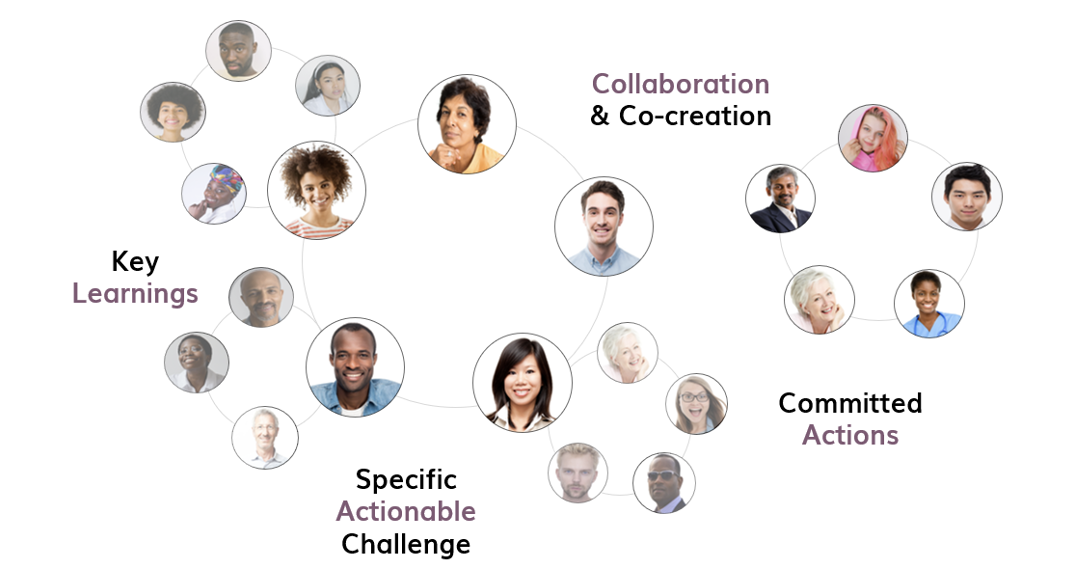
Innovation has top of corporate agendas for over a decade – often with limited results despite leadership training programs, the establishment of innovation hubs, joint ventures, and hackathons for inspiration and insight.
While companies invested $358 billion in corporate training in 2020, with $3.5 billion going to leadership training and solutions alone, only 21% of executives are confident that they have the expertise, resources, and commitment to pursue new growth successfully.
One reason is that approaching innovation and learning in isolation, through one-off initiatives and activities has only a fleeting impact on building long-term growth. Innovation today is increasingly driven by co-creating solutions in ‘real-time’, through learned experience to address the challenging circumstances of the changing world.
Just take the last two years for example, when the human potential and creativity manifested themselves in many ways – living spaces were reimagined to fit new purposes, businesses were launched from peoples’ homes, and mass products were modified to fit new customer needs.
All this was, for the most part, enabled not by guidelines, experts, or innovation conferences, but rather by learning through the Try-Fail-Grow approach, embracing uncertainty, sharing real-world experiences, and collaboration among brave individuals around the world.
How can business leaders tap into this enormous human potential to ensure future readiness? The Answer: Collaborate regularly in global peer circles, where individuals from diverse backgrounds, but with common goals, purpose, or challenges can openly share experiences, challenge one another, learn from each other, and commit to actions.
Collaboration in a diverse circle of peers allows individuals to get out of their ‘echo chambers’ and burst through ‘bubbles’ that impede innovation and growth in a traditional, corporate setting. How does it work in practice? One such ecosystem is facilitated by the Executive Growth Alliance, where global leaders from disparate backgrounds participate in bi-monthly (2-hour) facilitated Executive Growth Circles (EGC) to co-create new solutions and solve real-world business problems. What are the main bubbles that Executive Growth Alliance and other global peer circles help to burst?
1# The ‘I’m sure everyone knows what I am talking about’ bubble
One of the most common traps we fall into is believing that everyone around us can speak our ‘business talk’. Just like with regular language, this isn’t true and can be detrimental to collaboration when people sit in meetings afraid to ask what a certain acronym means. This goes to show how important it is to spend time outside of one’s regular ‘bubble’. Having your ‘business talk’ challenged in a peer circle can be a great opportunity to evaluate whether the language you use with your employees and customers is as clear as you thought.
2# The ‘I’ll just keep trying (the same thing) until it works’ bubble
How many times do we get tunnel vision and keep using the same approach to solving a challenge, getting more frustrated each time it doesn’t work? The content is not reaching my audience? I’ll just bombard them with more emails. My product is not profitable? I’ll just keep selling more, hoping it will get fixed. Often what you need is not a ‘bigger hammer’, but a new perspective which is exactly what a peer circle is about. When you work on a common specific challenge, sharing real-world experience often leads to finding new ways to address challenges that weren’t thought of before.
3# The ‘this problem just cannot be solved’ bubble
When we are too deep into the weeds of a business problem, it can often appear insurmountable from our point of view. Too often we say ‘I’ve tried everything, I am ready to throw in the towel’ when the solution might have been just one more try away. Executive Growth Alliance members embrace the Crisitunity mentality – that every crisis holds within it an opportunity. Through sharing personal experiences, they are always able to find a solution that hasn’t been considered yet.
4# The ‘It needs to be perfect in order to work’ bubble
In today’s interconnected business world, the most sustainable solutions are often not those built in a traditional manner, but alternatives designed to meet the needs of people that will use them.
One key learning which has been gained by members of the Executive Growth Alliance was that you need to bring people along the journey of change – otherwise they won’t go. This can be hard for some business leaders, who through spending time ‘inside their bubble’ are not used to being challenged or disagreed with. Regular participation in a peer circle can be a great nudge towards becoming more inclusive and open-minded in the regular work setting too.
In today’s unpredictable world, traditional ways of gaining inspiration and insight no longer work. Business leaders have an opportunity to tap into the immense potential of peer collaboration to co-create innovation and growth through the Executive Growth Alliance. Are you ready to try this approach and burst the bubbles that inhibit your creativity and innovation?
Next Step’s EGA is a global community of Open Committed Brave leaders who collaborate to prepare for the future. Through facilitated peer circles, they address common challenges and co-create new opportunities – gaining leadership skills, confidence, partners; enhanced corporate sustainability, and impact on society. Find out more about the global EGA community, Executive Growth Circles, and the need for greater collaboration between global business leaders on executivegrowthalliance.com.
